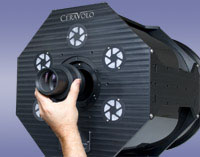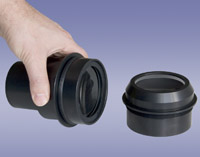The Ceravolo Interchangeable Field Correctors
Most Cassegrain telescopes are long focal length, slow speed instruments, typically f/8 to f/15. While this configuration is ideal for high resolution imaging, astro-imagers who desire a wide field of view and shorter exposures must resort to either a focal reducer or a second telescope. Two high-end telescopes are expensive and it is not possible to design a focal reducer capable of filling a large CCD with sharp images.


Peter Ceravolo's goal was to design a telescope capable of working at both short and long focal lengths and still form sharp images to the corner of a large CCD. In a reversal of the conventional approach to telescope design, Ceravolo's baseline Cassegrain optics work at a very fast f/4.9 and cover a wide field of view with the aid of the integral field corrector lenses. The high resolution configuration is achieved by swapping the f/4.9 field corrector lens group with another three-element field corrector with amplifying power, making the system f/9.
The Ceravolo 300 Astrograph's built-in field correctors produce razor-sharp star images to the corners of a large CCD. They are an integral part of the optical system, not an accessory. This approach allowed the design to be rebalanced by redistributing the workload among the mirrors and lenses, eliminating the usual aspheric secondary. The resultant Cassegrain mirror system resembles a Dall-Kirkham Cassegrain (elliptical primary and spherical secondary figures) with the addition of a triplet field corrector lens group positioned just behind the primary mirror.
 The field corrector in the baseline f/4.9 configuration has a near zero net optical power, and consequently no chromatic aberration is introduced by the lenses. No spectral dispersion is detectable from the near UV to the near IR, which is the typical spectral band covered by today's advanced CCD detectors. And as seen by the examples in the image gallery, even the f/9 configuration's field corrector is highly color corrected.
The field corrector in the baseline f/4.9 configuration has a near zero net optical power, and consequently no chromatic aberration is introduced by the lenses. No spectral dispersion is detectable from the near UV to the near IR, which is the typical spectral band covered by today's advanced CCD detectors. And as seen by the examples in the image gallery, even the f/9 configuration's field corrector is highly color corrected.
The Ceravolo 300 Astrograph offers two interchangeable field corrector cells: f/4.9 for wide field imaging and f/9 for high resolution making this the most unique and versatile imaging system on the market.